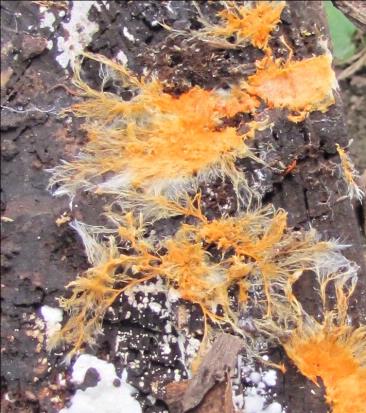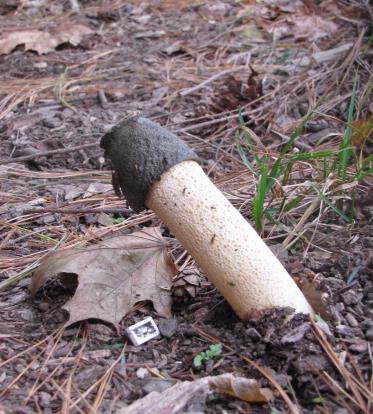When Moses bugged out of Egypt with the Israelites, he was in such a rush that they didn’t let their bread rise: they baked it flat. Apparently no one thought to keep a little starter on the side. On Passover Jews commemorate this event by avoiding leavening: they eat matzo. The common leavening we bake with is yeast, a fungus. Saccharomyces cerevisiae and lots of other wild yeasts occur naturally in the air just about everywhere. In the process of making energy for themselves, yeasts turn carbohydrates into alcohol and carbon dioxide. Incidentally (at least to the yeast) causing bread to rise. The same species turns sugary malted barley mash or cider into refreshing beverages with pleasant side-effects and not-so pleasant after-effects. They also turn grape juice into wine. They remind me of another famous Israelite who did great things with water.
Yeast, the ubiquitous button mushroom, and the death cap, Amanita phalloides, are all fungi. They have cell walls made of chitin (just like the exoskeleton of insects). They grow all over the world and can eat just about anything alive or formerly alive. Mushrooms make up the smallest fraction of the fungal organism. Most of a fungus’ cells are underground and look like stringy hairs netted together through the soil or wood; they’re called mycellium. They grow exclusively on organic matter because unlike plants, but just like us, fungus can’t make its own food. Instead fungi depend on others. The Israelites let the yeast down, not the other way around. Some fungi are parasites like the honey mushroom, Armillaria. Though apparently tasty, the various species of Armillaria can lay waste to hundreds of acres of forest. The largest organism in the world is an Armillaria solidipes that is slowly eating a forest in the Malheur National Forest in Washington. Other fungi just clean up the mess made by the rest of an ecosystem’s biota. They break down dead plants, animals and poop into usable nutrients that other organisms can then eat. Most conspicuously, fungi are the only organisms that can digest the molecule lignin in wood. Without these hard working little mycelia, we’d be buried in debris. Some fungi have worked out a deal with plants. The plant gives the fungus carbohydrates and the fungus provides the plant with nutrients and hunts out water when the soil dries out. The fungus effectively extends the root system of the plant many times over. Often fungal cells invade the plant cells then send mycelia out into the soil. Almost every plant forms some sort of symbiotic relationship with fungal partners when growing in the wild. It’s been a good year for mushrooms. I noticed the pictured stinkhorn growing near the play structure in our yard. It is clearly not suitable for children. But it set me to wondering how much fungal helpers are absent in my garden. Tillage disturbs the fragile mycelia. Probably more importantly, many plants form relationships with particular fungal species. Blueberries have been particularly troublesome for me and they only work with a relatively rare fungus (at least rare to the average town lawn). Perhaps it would do me good to enlist some allies in my quest for sustainability. I smell an experiment in the works.
When Moses bugged out of Egypt with the Israelites, he was in such a rush that they didn’t let their bread rise: they baked it flat. Apparently no one thought to keep a little starter on the side. On Passover Jews commemorate this event by avoiding leavening: they eat matzo. The common leavening we bake with is yeast, a fungus. Saccharomyces cerevisiae and lots of other wild yeasts occur naturally in the air just about everywhere. In the process of making energy for themselves, yeasts turn carbohydrates into alcohol and carbon dioxide. Incidentally (at least to the yeast) causing bread to rise. The same species turns sugary malted barley mash or cider into refreshing beverages with pleasant side-effects and not-so pleasant after-effects. They also turn grape juice into wine. They remind me of another famous Israelite who did great things with water.
Yeast, the ubiquitous button mushroom, and the death cap, Amanita phalloides, are all fungi. They have cell walls made of chitin (just like the exoskeleton of insects). They grow all over the world and can eat just about anything alive or formerly alive. Mushrooms make up the smallest fraction of the fungal organism. Most of a fungus’ cells are underground and look like stringy hairs netted together through the soil or wood; they’re called mycellium. They grow exclusively on organic matter because unlike plants, but just like us, fungus can’t make its own food. Instead fungi depend on others. The Israelites let the yeast down, not the other way around. Some fungi are parasites like the honey mushroom, Armillaria. Though apparently tasty, the various species of Armillaria can lay waste to hundreds of acres of forest. The largest organism in the world is an Armillaria solidipes that is slowly eating a forest in the Malheur National Forest in Washington. Other fungi just clean up the mess made by the rest of an ecosystem’s biota. They break down dead plants, animals and poop into usable nutrients that other organisms can then eat. Most conspicuously, fungi are the only organisms that can digest the molecule lignin in wood. Without these hard working little mycelia, we’d be buried in debris.

Some fungi have worked out a deal with plants. The plant gives the fungus carbohydrates and the fungus provides the plant with nutrients and hunts out water when the soil dries out. The fungus effectively extends the root system of the plant many times over. Often fungal cells invade the plant cells then send mycelia out into the soil. Almost every plant forms some sort of symbiotic relationship with fungal partners when growing in the wild.

It’s been a good year for mushrooms. I noticed the pictured stinkhorn growing near the play structure in our yard. It is clearly not suitable for children. But it set me to wondering how much fungal helpers are absent in my garden. Tillage disturbs the fragile mycelia. Probably more importantly, many plants form relationships with particular fungal species. Blueberries have been particularly troublesome for me and they only work with a relatively rare fungus (at least rare to the average town lawn). Perhaps it would do me good to enlist some allies in my quest for sustainability. I smell an experiment in the works.


